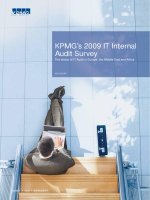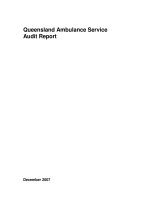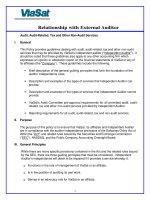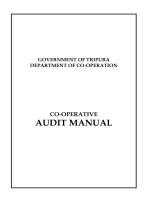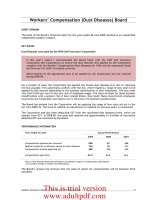Legislative Audit Division_part1 pot
Bạn đang xem bản rút gọn của tài liệu. Xem và tải ngay bản đầy đủ của tài liệu tại đây (102.45 KB, 10 trang )
Legislative Audit Division
State of Montana
Report to the Legislature
March 2007 Financial Audit
For the Fiscal Year Ended June 30, 2006
Montana Water Pollution Control
and Drinking Water State Revolving
Fund Programs
Department of Environmental Quality
Department of Natural Resources and Conservation
We performed a financial audit of the Montana Water Pollution Control
and Drinking Water State Revolving Fund Programs for the fiscal year
ended June 30, 2006. This report contains the audited financial statements
and accompanying notes for fiscal year 2005-06. We issued an unqualified
opinion on the financial statements. This opinion means the reader may
rely on the financial information presented.
Direct comments/inquiries to:
Legislative Audit Division
Room 160, State Capitol
PO Box 201705
07-25 Helena MT 59620-1705
/>Help eliminate fraud, waste, and abuse in state government. Call the Fraud Hotline at
1-800-222-4446 statewide or 444-4446 in Helena.
This is trial version
www.adultpdf.com
FINANCIAL AUDITS
Financial audits are conducted by the Legislative Audit Division to determine if the financial
statements included in this report are presented fairly and the agency has complied with laws and
regulations having a direct and material effect on the financial statements. In performing the
audit work, the audit staff uses standards set forth by the American Institute of Certified Public
Accountants and the United States Government Accountability Office. Financial audit staff
members hold degrees with an emphasis in accounting. Most staff members hold Certified Public
Accountant (CPA) certificates.
The Single Audit Act Amendments of 1996 and OMB Circular A-133 require the auditor to issue
certain financial, internal control, and compliance reports in addition to those required by
Government Auditing Standards. This individual agency audit report is not intended to comply
with these requirements. The Legislative Audit Division issues a statewide biennial Single Audit
Report which complies with the above reporting requirements. The Single Audit Report for the
two fiscal years ended June 30, 2005, was issued March 6, 2006. The Single Audit Report for the
two fiscal years ended June 30, 2007, will be issued by March 31, 2008. Copies of the Single
Audit Report can be obtained by contacting:
Single Audit Coordinator Legislative Audit Division
Office of Budget and Program Planning Room 160, State Capitol
State Capitol PO Box 201705
Helena MT 59620 Helena MT 59620-1705
Phone (406) 444-3616
MEMBERS OF THE LEGISLATIVE AUDIT COMMITTEE
Senator Joe Balyeat, Vice Chair Representative Betsy Hands
Senator John Brueggeman Representative Hal Jacobson
Senator Jim Elliott Representative Bill Glaser
Senator Dan Harrington Representative Scott Mendenhall
Senator Lynda Moss Representative John Musgrove, Chair
Senator Corey Stapleton Representative Janna Taylor
This is trial version
www.adultpdf.com
LEGISLATIVE AUDIT DIVISION
Scott A. Seacat, Legislative Auditor Deputy Legislative Auditors:
Tori Hunthausen, James Gillett
Chief Deputy Legislative Auditor Angie Grove
Room 160, State Capitol Building, PO Box 201705 Helena, MT 59620-1705
Phone (406) 444-3122 FAX (406) 444-9784 E-Mail
March 2007
The Legislative Audit Committee
of the Montana State Legislature:
This is our report on the fiscal year 2005-06 financial audit of the Montana Water Pollution Control State
Revolving Fund (WPCSRF) and Drinking Water State Revolving Fund (DWSRF) Programs. The
Department of Natural Resources and Conservation requested the audit of these programs because
annual audits are required by the federal Environmental Protection Agency. These programs are
administered jointly by the Department of Natural Resources and Conservation and the Department of
Environmental Quality.
The objectives of a financial audit include determining if the programs’ financial statements present
fairly their financial position at June 30, 2006, and the results of the programs’ operations for the fiscal
year then ended. We tested compliance with state and federal laws that have a direct and material impact
on the financial statements.
The WPCSRF program provides loans at a reduced interest rate to finance construction of publicly
owned water pollution control facilities, nonpoint source pollution control projects, and estuary
management plans. Water pollution control loans are comprised of federal grants and state match funds
and may be financed up to 30 years. As of June 30, 2006, the WPCSRF had $139,083,137 of
outstanding loans, including advances to other funds.
The DWSRF program provides low interest loans to communities for the construction of drinking water
treatment facilities. Drinking water loans are comprised of federal grants and state match funds and may
be financed up to 30 years. At June 30, 2006, the DWSRF had $69,572,784 of outstanding loans.
On page A-1, you will find the Independent Auditor’s Report followed by the financial statements and
accompanying notes. We issued an unqualified opinion which means the reader can rely on the
presented information. The programs’ financial statements begin on page A-3. Our opinion on the
programs’ supplementary financial information is on page B-1. The supplementary information begins
on page B-3. Beginning on page C-1 is our report on compliance and internal control, which is required
by Government Auditing Standards issued by the Comptroller General of the United States.
Officials from both departments have reviewed this report and agree with its contents. The
Department of Environmental Quality’s response is at page D-1. We thank the directors of the
Department of Environmental Quality and the Department of Natural Resources and
Conservation and their staff for their cooperation and assistance during the audit.
Respectfully submitted,
/s/ Scott A. Seacat
Scott A. Seacat
Legislative Auditor
This is trial version
www.adultpdf.com
Appointed and Administrative Officials
Page i
Department of
Environmental Quality
Richard Opper, Director
Tom Livers, Deputy Director
Dean Rude, Chief Financial Officer, Financial Services
Department of Natural
Resources and Conservation
Mary Sexton, Director
Anna Miller, Financial Advisor
Ann Bauchman, Administrator, Centralized Services Division
For additional information concerning the Montana Water Pollution
Control and Drinking Water State Revolving Fund Programs,
contact Anna Miller, Financial Advisor, at:
PO Box 201601
Helena MT 59620-1601
(406) 444-6689
e-mail:
The audit staff involved in this audit were Rick Eneas,
Cindy Jorgenson, and Jeff Tamblyn.
This is trial version
www.adultpdf.com
LEGISLATIVE AUDIT DIVISION
Scott A. Seacat, Legislative Auditor Deputy Legislative Auditors:
Tori Hunthausen, James Gillett
Chief Deputy Legislative Auditor Angie Grove
Room 160, State Capitol Building, PO Box 201705 Helena, MT 59620-1705
Phone (406) 444-3122 FAX (406) 444-9784 E-Mail Page A-1
INDEPENDENT AUDITOR’S REPORT
The Legislative Audit Committee
of the Montana State Legislature:
We have audited the accompanying Combined Balance Sheet of the Montana Water Pollution Control
and Drinking Water State Revolving Fund Programs as of June 30, 2006, and the related Combined
Statement of Revenues, Expenditures, and Changes in Fund Balances for the fiscal year then ended. The
information contained in these financial statements is the responsibility of the management of the
Montana Department of Environmental Quality and the Montana Department of Natural Resources and
Conservation. Our responsibility is to express an opinion on these financial statements based on our
audit.
We conducted our audit in accordance with auditing standards generally accepted in the United States of
America and standards applicable to financial audits contained in Government Auditing Standards, issued
by the Comptroller General of the United States. Those standards require that we plan and perform the
audit to obtain reasonable assurance about whether the financial statements are free of material
misstatement. An audit includes examining, on a test basis, evidence supporting the amounts and
disclosures in the financial statements. An audit also includes assessing the accounting principles used
and significant estimates made by management, as well as evaluating the overall financial statement
presentation. We believe that our audit provides a reasonable basis for our opinion.
As discussed in the notes to the financial statements, the financial statements of the Montana Water
Pollution Control and Drinking Water State Revolving Fund Programs are intended to present the
financial position and results of operations of only that portion of the financial reporting entity of the state
of Montana that is attributable to the transactions of the programs.
In our opinion, the financial statements referred to above present fairly, in all material respects, the
financial position of the Montana Water Pollution Control and Drinking Water State Revolving Fund
Programs as of June 30, 2006, and results of operations for the fiscal year then ended, in conformity with
accounting principles generally accepted in the United States of America.
This is trial version
www.adultpdf.com
Page A-2
In accordance with Government Auditing Standards, we have also issued our report dated
January 12, 2007, on our consideration of the programs’ internal control over financial reporting and on
our tests of its compliance with certain provisions of laws, regulations, contracts, and grant agreements
and other matters. The purpose of that report is to describe the scope of our testing of internal control
over financial reporting and compliance and results of that testing and not to provide an opinion on the
internal control over financial reporting or on compliance. That report is an integral part of an audit
performed in accordance with Government Auditing Standards and should be considered in assessing the
results of our audit.
Respectfully submitted,
/s/ James Gillett
James Gillett, CPA
January 12, 2007 Deputy Legislative Auditor
This is trial version
www.adultpdf.com
MONTANA WATER POLLUTION CONTROL AND DRINKING WATER
STATE REVOLVING FUND PROGRAMS
COMBINED BALANCE SHEET
SPECIAL REVENUE AND DEBT SERVICE FUNDS
JUNE
30,2006
WATER POLLUTION CONTROL DRINKING WATER
STATE SPECIAL FEDERAL SPECIAL DEBT STATE SPECIAL FEDERAL SPECIAL DEBT
ASSETS REVENUE REVENUE SERVICE REVENUE REVENUE SERVICE TOTAL
Cash and Cash Equivalents
$11,145,720 $17.1 92 $2,865,964 $3,363,132 $83,209 $1,955,512 $19,430,729
Interest Receivable
412,561 1,669,382 99.942 370,978
2,552,863
Due from Federal Government
8,717 65,337 74,054
Prepaid Expenses
466 895 1,361
Investments
979,658 178,845 2,946,269 324,827 4,429,599
Loans Receivable
126,382,557 69,572,784 195,955,341
Advances to Other Funds
12,700,580 12,700,580
Total Assets
$151,621.542 $25,909 $4,714,191 $75,983,022 $148.546 $2,651,317 $235,144,527
LIABILITIES AND FUND BALANCES
Liabilities:
Accounts Payable
$12 $21 0 $42,858 $43,080
Payroll Payable
3,480 12,178 $13,645 33,034 62,337
Interest Payable
351.323 113,351 464,674
Loans Payable
25,000 25,000
Deferred Revenue
13,522 47.654 61,176
Total Liabilities
$354,815 $25,910 $126,996 $1 48,546 $656,267
Fund
Balances
Reserved for Loans Receivable
$139,083,137
Reserved for Debt Service
. .
,-~
.
-~
Unreserved, Undesignated
12,183,590 6,283,242 1 18,466,833
Total Fund Balances
$151,266,727 $4,714,191 $75,856,026
$
-
$2,651,319 $234,488,263
Total Liabilities and Fund Balances
$151,624,542 $25,910 $4,714,191 $75,983.022 $1 48,546 $2,651,319 $235,144,530
The accompanying notes to the financial statements are an integral part of this statement.
This is trial version
www.adultpdf.com
MONTANA WATER POLLUTION CONTROL AND DRINKING WATER
STATE REVOLVING FUND PROGRAMS
COMBINED STATEMENT OF REVENUES, EXPENDITURES, AND CHANGES IN FUND BALANCES
SPECIAL REVENUE AND DEBT SERVICE FUNDS
FOR THE FISCAL YEAR ENDED JUNE
30,2006
WATER POLLUTION CONTROL DRINKING WATER
STATE SPECIAL FEDERAL SPECIAL DEBT STATE SPECIAL FEDERAL SPECIAL DEBT
REVENUE REVENUE SERVICE REVENUE REVENUE SERVICE TOTAL
RNENUES:
Federal Capitalization Grant Revenue
$4,320,125 $12,894,079 $1 7.214.204
Interest Income on Investments
$489,005 $66.402 $181,440 $278,576 1,015.423
Other Investment Income
59.214 (72,741) 107.985 18.817 113,275
Interest income from Loans
1,064.937 4,428,867 429,084 1,760.608 7,683,496
Other Income
(489) 30 2 146 (311)
TOTAL REVENUES
51,612,667 $4.320.155 $4,422,528 $718,511 $12,894,225 $2,058,001 $26,026.087
EXPENDITURES:
Program
AdministrationlSet-Asides
$127.421
$398,199 $130,223
$1,251,272 $1.907.115
TOTAL EXPENDITURES
$127,421
$398.199
$0 $130,223
$1,251,272
$0
$1,907.115
Excess Revenues
Over
(Under) Expenditures
$1.485.246 $3.921,956 $4.422.528 $588.288 $11,642,953 $2,058,001 $24,118.972
OTHER FINANCING SOURCES:
Operating Transfers
In:
FYO5
Slate Match Reimbursement from WPC SRF
Reverse
FYO5
Recycled Transfer from WPC SRF
($85.000)
Debt Service SHsep
1,452,030
Loan Loss Reserve Svaep
1,124,036
Federal Ca~italization Grants
3.850.236
Transfer frim Investment Fund for Bond Payments
$649,292 $61 0,243 1,259,535
Total Other Financing Sources
$6,341,302 $649.292 $12,160,145 $136 $610.243 $19,761,118
OTHER FINANCING USES:
Bond Principal Payments
$1,830,000 fl.lO0,OOO $2,930,000
Bond Interest Payments
715.756 528,908 1,244,664
Operating Transfern Out:
M05
State Match Reimbursement to Drinking Water
$1 36 136
Reverse
FY05
Recycled Transfer to Drinking Water
(85.000) ($85.000) (170,000)
Debt Service Sweep
1,452,030 436,871 1,888,901
Loan Loss Reserve Svmep
1,124,036 95,911 1,219.947
Federal Capitalization Grants
$3,850.236 $11,712,227 15,562,483
Transfer to Debt Service for Bond Payments
649,292 61 0,243 1,259,535
Tolal Other Financing Uses
$564,428 $3,850,236 $5,121,822 $525,243 $1 1.712.227 $2,161,690 $23,935,646
Excess (deficiencv)
of
revenues and othe~
financing sources
-
over (under) expenditures
and other financing uses
$7,262,120 $71,720 ($50.002) $12.223.190 ($69,138) $506,554 $19,944,444
Fund Balances July
1,2005 $143.991.018 ($2,448) $4,764,192 $63,623,588
$0 $2,144,765 $214,521,115
Prior Year and Federal Revenue Adjustments
13.591 (69,273) 2 9.249 69,138 0 22,707
Fund Balances June
30.2006 $151 266,729
9
The accompanying notes
to
the financial statements
are
an integral part
of
this statement.
This is trial version
www.adultpdf.com
MONTANA STATE WATER POLLUTION CONTROL AND
DRINKING WATER STATE REVOLVING FUND PROGRAMS
SPECIAL REVENUE AND DEBT SERVICE FUND
NOTES TO FINANCIAL STATEMENTS
FOR THE FISCAL YEAR ENDED JUNE 30,2006
1.
Organization of the Programs
The State of Montana Water Pollution Control State Revolving Fund (WPCSRF) Program was
established pursuant to Title
VI
of the Federal Water Quality Act of 1987. This federal act
established the WPCSRF program to replace the construction grants program. It provides a
flexible financing source to loan money at reduced interest rates to finance the construction of
publicly owned water pollution control facilities, non
-
point source pollution control projects, and
estuary management plans. Instead of making grants to
comnhmities that pay for a portion of
building wastewater treatment facilities, the WPCSRF provides for low interest rate loans to
finance the entire cost of qualified projects.
The State of Montana Drinking Water State Revolving Fund (DWSRF) Program was established
pursuant to Title
XIV
of the Safe Drinking Water Act. This federal act established the DWSRF
program for states to make loans to community water systems and non
-
profit non
-
community
water systems. Instead of making grants to communities that pay for a portion of building
drinking water
treatment facilities, the DWSRF provides for low interest rate loans to finance the
entire cost of qualified projects or to refinance debt obligations on projects that began after July
1, 1993. The State of Montana first incurred expenditures in the DWSRF Program in state fiscal
year (SFY) 1997.
WPCSRF and DWSRF loan agreements allow up to
30
years for repayment. All repayments of
interest and principal must remain in the revolving funds. Both programs are capitalized through
U.S. Environmental Protection Agency (EPA) grants. States are required to provide
20
percent
of the federal capitalization grant as matching funds for DWSRF, and 16.67 percent for
WPCSRF, in order to receive a grant. The State of Montana issues General Obligation Bonds to
provide the required state matching funds.
The programs are jointly administered by the Technical and Financial Assistance Bureau of the
Department of Environmental Quality (DEQ) and the Conservation and Resource Development
Division of the Department of
Natural Resources and Conservation (DNRC). The revolving
fund programs do not have any full time employees. Both funds are charged for time spent on
SRF activities by department employees. The charges include salaries and benefits of the
employees and operating expenses as well as indirect costs.
2. Summary of Significant Accounting Policies
A. State Revolving Fund (SRF) Program Fund Structure
Both programs use Special Revenue and Debt Service funds, as appropriate, to report the
financial position and the results of operations. A Special Revenue Fund accounts for the
~~
~
Page
A
-
5
This is trial version
www.adultpdf.com
proceeds of specific revenue sources that are restricted to expenditures for specified purposes. A
Debt Service Fund accounts for resources accumulated for payment of principal and interest on
general long
-
term obligation debt. Montana maintains a State Special Revenue and a Federal
Special Revenue Fund. The
SRF program revenue and expenses include transactions from each
Special Revenue Fund. Special Revenue and Debt Service Funds are considered governmental
funds.
A fund is a separate accounting entity with a self
-
balancing set of accounts. Fund accounting is
designed to demonstrate legal compliance and to aid financial management by segregating
transactions related to certain government functions and activities.
B. Basis of Accounting
The accounting and financial reporting treatment applied to a fund is determined by its
measurement focus. All governmental funds are accounted for using a current financial
resources measurement focus. Current financial resources means that, generally, only assets and
current liabilities are included on the balance sheet. Operating statements of governmental funds
present increases (revenues and other financing sources) and decreases (expenditures and other
financing uses) in net current assets.
Governmental funds use the modified accrual basis of accounting. The modified accrual basis is
the accrual basis adapted to the governmental fund
-
type measurement focus. Under the modified
accrual basis of accounting, revenues are recorded when received in cash unless susceptible to
accrual. Revenues are susceptible to accrual if they are measurable and available within sixty
days after the end of the fiscal year to finance expenditures of the fiscal year. Revenues are
deferred if material and received before the normal time of receipt or if received for a particular
activity and the expense for that activity has not been incurred prior to fiscal year
-
end.
Expenditures are recognized when the related fund liability is incurred, with the following
exceptions:
1)
principal and interest on long
-
term debt are recognized when due;
2)
prepayments are accounted for as expenditures in the period of acquisition;
3)
inventory items are considered expenditures when purchased.
The Loans Receivable account resides in the State Special Revenue fund for each program. This
account represents the total principal due on the loans outstanding for each program.
C.
Prior Period Adiustments
Prior period adjustments reported in the accompanying financial statements relate to corrections
of errors or other correcting adjustments from prior periods not otherwise reported as sources or
uses of funds.
-
-
-
Page
A
-
6
This is trial version
www.adultpdf.com

